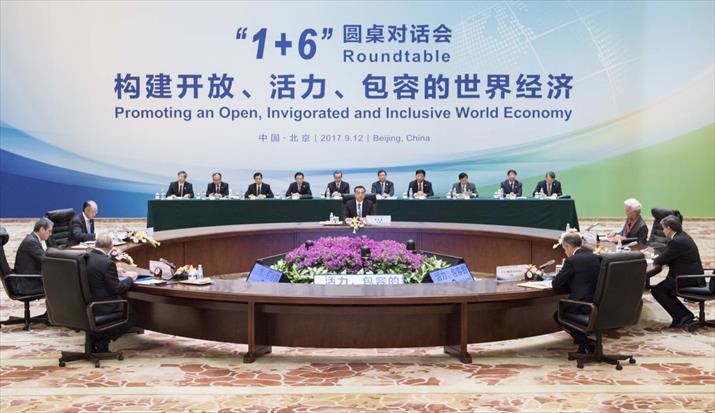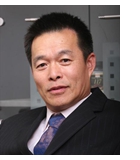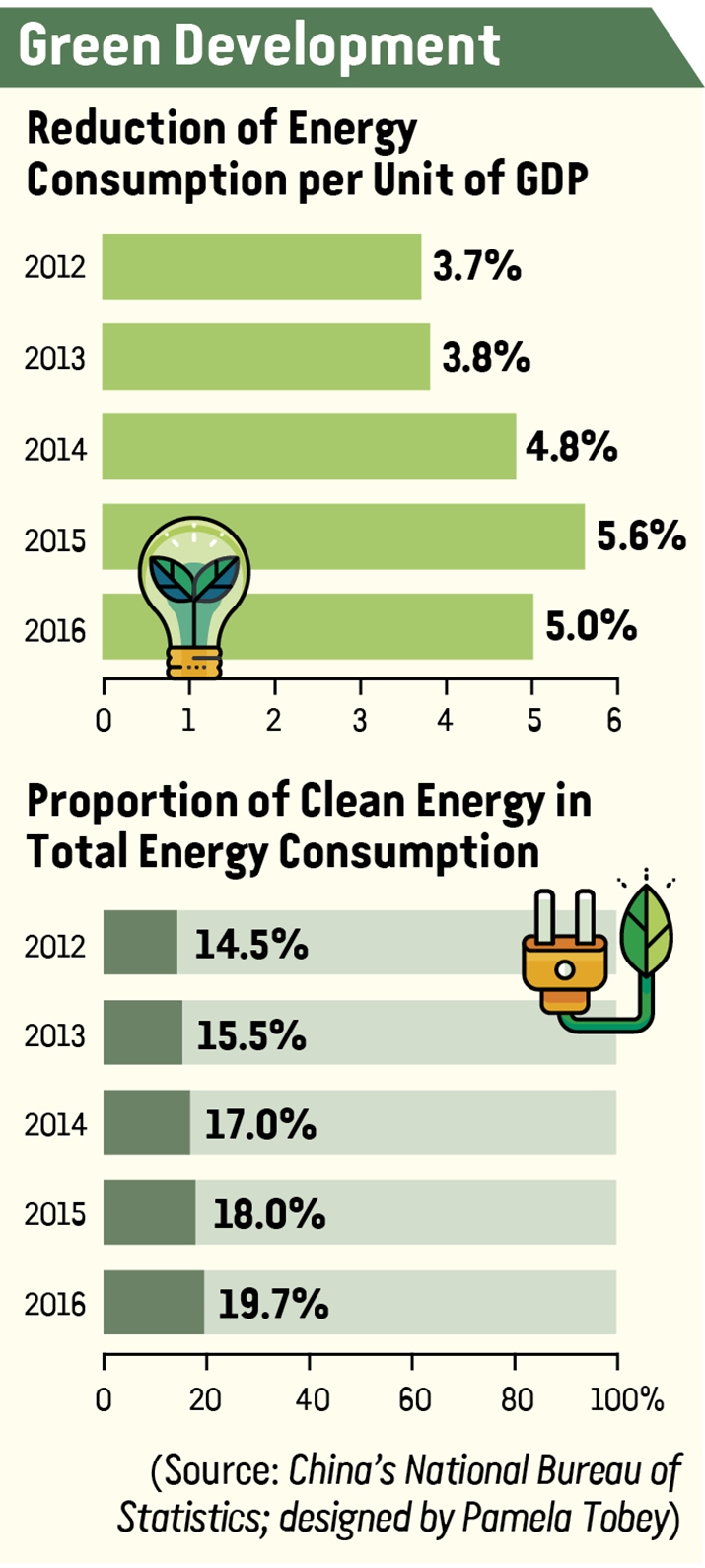
The Second "1+6" Roundtable meeting of Chinese Premier Li Keqiang (center) and heads of six international organizations is held in Beijing on September 12(XINHUA)

One of the most remarkable achievements China has made since the 18th CPC National Congress is in ecological preservation. The goal of pursuing ecological progress has been put into practice ever since it was included in the CPC Constitution five years ago.
China’s investment in improving the environment has doubled during the past five years and reached an unprecedented level, and its green energy sector has seen explosive growth. It has become a large natural gas consumer, with 300 million people—nearly equaling the U.S. population—using this clean energy. In 2012, clean energy, which also includes hydro, wind, solar and nuclear power accounted for 14.5 percent of the total energy consumed in the country. This rose to nearly 20 percent in 2016, and the ratio in northwest China's Qinghai Province even reached 80 percent. Compare this to California, the United States, which aims to have 50 percent of its energy demand fueled by green sources by 2050.
Another highlight of China's green development efforts during the past five years is its enhanced actions to address climate change. During the APEC Economic Leaders' Meeting in 2014, China and the United States issued a joint statement, providing momentum for the Paris climate agreement to be signed in 2015. China then submitted its Intended Nationally Determined Contributions plan to the Secretariat of the United Nations Framework Convention on Climate Change in 2015. While reducing its own carbon dioxide emissions, China has helped other developing countries cope with climate change. Although the United States has stated that it is withdrawing from the Paris agreement, China is actively engaged in the fight against climate change. The negative effect of the U.S. exit can be offset by China's efforts to reduce emissions.
China has also dealt with the challenging relationship between economic development and environmental protection. The Yangtze River Economic Belt is one example. President Xi Jinping has stressed that restoring the Yangtze's ecology will be an overwhelming task, and no large development projects will be allowed along the longest river in China in the foreseeable future. This approach represents a fundamental change in China's development philosophy. Therefore, green development in China might be called a "green revolution" or an "ecological revolution."
China has charted its own way to implement this philosophy. Its 11th Five-Year Plan (2006-10) set out the goal of "building a resource-conserving and environment-friendly society." Following that, "green development" was included in the 12th Five-Year Plan (2011-15). Ecological investment during this period doubled compared to the previous five years, and all the ecological and environment-related targets in the 12th Five-Year Plan have been fulfilled. Progress is continuing during the 13th Five-Year Plan (2016-20) period.
Local government officials have also shifted from the overarching pursuit of "regional GDP growth" to prioritizing "green hills and clear waters." In addition to mandatory targets introduced during the 11th Five-Year Plan period that increase the government's responsibilities in environmental protection, an environment inspection initiative has been launched, and thus the trend of environmental deterioration has been curbed.
Environmental protection is not a campaign, but a long-term endeavor. A next focus is on building a "beautiful China," which has both environmental and cultural significance.
Despite recent environmental achievements, challenges still lie ahead. The contrast between China's large population and limited resources remains the nation’s weakest strength. However, as a developing country, China needs to modernize and become more prosperous to ensure the creation of a "beautiful China." Meanwhile, there are major green development projects to be completed. China also needs to figure out how to complete the system for ecological investment, so as to encourage innovation.
As Xi has said, a good environment is the best public good for all. Green innovation is a huge business opportunity and will bring benefits to the people. For example, the Elion Resources Group employs locals to fight desertification in the Hobq Desert in northern China's Inner Mongolia Autonomous Region. Elion gains profits from the project, the environment has improved substantially and local farmers' incomes have increased. Moreover, a medicinal plant has been found in the desert, which has become a new source of income for local farmers.
Innovative concept
Xi has proposed the concept of innovative, coordinated, green, open and shared development. With the development of Chinese people at its core, it is solution-oriented.
Green development, for example, is intended to bridge the large gap between humans and nature, which is the biggest challenge China is facing. In order to create a "beautiful China," the 13th Five-Year Plan has set the goal of improving the overall environment, which includes improving the quality of air, soil, water and more, and all the targets in the plan must be fulfilled.
The new development concept is, in fact, an innovative theory that refreshes people's knowledge about development economics. It will bring great changes to China, as such innovative ideas always bring big changes to the world.

Global recognition
China's solutions to global growth were included in the agenda of the 2014 APEC Economic Leaders' Week in Beijing. The theme of last year's G20 Summit in Hangzhou—Toward an Innovative, Invigorated, Interconnected and Inclusive World Economy—also echoed China’s concept of innovative, coordinated, green, open and shared development.
Another example is the "1+6" Roundtable meeting hosted by Chinese Premier Li Keqiang, which included China's supply-side structural reform in the global governance framework for the first time. The meeting, held twice in Beijing, on July 22, 2016 and September 12, 2017, was attended by the heads of six international bodies: World Bank Group (WBG), International Monetary Fund (IMF), World Trade Organization, International Labor Organization (ILO), Financial Stability Board and the Organization for Economic Cooperation and Development.
The world is standing at a crossroads. It's been almost 10 years since the global financial crisis broke out in 2008, but the world has yet to rid itself of the ensuing recession. Although the United States hasn't put forward a global leadership plan, China has proposed solutions to meet some of the world's urgent demands, such as the consensuses reached at the second "1+6" meeting.
China's development is beneficial to the world and vice versa. The meeting is designed to examine common challenges around the world, reverse the anti-globalization trend and promote "an open, invigorated and inclusive world economy."
Poverty and unemployment have been two of the world’s persistent problems. The international community has made efforts to reduce poverty. However, unemployment remains a tough issue for most countries, be they developed or developing. That's why the "1+6" meeting invited the ILO’s director general.
China outperforms many other countries in terms of employment facilitation. The 13th Five-Year Plan has set the goal of creating 10 million jobs each year—1 million more annually than that of the 12th Five-Year Plan period. In fact, China has created more than 13 million jobs each year since 2013.
Usually, the unemployment rate is an index of reference. China has adopted its employment target as its core index ever since its 10th Five-Year Plan (2001-05) period. While China is trying to keep the unemployment rate low, it mainly aims to create jobs.
In terms of inclusive employment growth, China has also done a good job. Although India's population is almost as large as China's, World Bank data show that India had a labor force of 511 million in 2016, much less than China's 802 million. The large discrepancy lies in the number of female laborers. The number of jobs that China has created for women is the highest in the world. That's a manifestation of inclusive growth.
A reform promoter
According to World Bank data, China's economy, when measured by purchasing power parity (PPP), surpassed that of the United States in 2014 to become the world's largest, and is expected to make up one-fifth, the largest share, of the world economy by 2020. Therefore, it's inevitable that China comes to the center of the world stage.
In terms of comprehensive national strength, some indicators show that China has already outpaced the United States since 2010. Take technological resources, the determining factor for future competition, as an example: In 2000, the United States' technological resources were 6.46 times those of China. In 2015, however, China overtook the United States. This is a result of increases in research and development and in the number of awarded patents and published scientific papers, all of which are almost at the same levels as in the United States.
Despite its rapid development in recent years, China does not seek to overturn the current global economic governance framework and build a new one, but to promote the reform and development of existing international organizations.
As the "1+6" Roundtable consensus on global economic governance states: "We reiterate our commitment to a strong, quota-based and adequately resourced IMF to preserve its role at the center of the global financial safety net. We reiterate our commitment to a strong, adequately resourced WBG to pursue its mission of eliminating extreme poverty and boosting shared prosperity in partnership with others."
The author is dean of the Institute for Contemporary China Studies at Tsinghua University